
Added padding: One solution to patient comfort
A couple of days ago I was in the zone. Shawna’s surgical mask hid her face, but I knew she was smiling. My banter was enough to make her laugh out loud a few times, so much that she paused while laying out the stainless steel instruments that soon would be probing the all too deep pockets between my teeth and gums.
A couple of days ago I was in the zone. Shawna's surgical mask hid her face, but I knew she was smiling. My banter was enough to make her laugh out loud a few times, so much that she paused while laying out the stainless steel instruments that soon would be probing the all too deep pockets between my teeth and gums.
To say a trip to the dentist is my least favorite activity is a gross understatement. Therefore, it's easy to understand that any respite from the process, no matter how short, was welcome.
To be fair, my dental visits aren't really that bad. But my dentist, being the genius that he is, knows that stress can amplify the slightest bit of discomfort. And Shawna, being the apt student of human nature that she is, recognized that I was a prime candidate for the kind of stress relief that my dentist had built into the chair.
I soon learned that not only was this chair well padded, but it included a slowly undulating massager that, a moment after activation, began gently rolling from side to side, up and down my spine. As I lay there, thinking about the massage and the cushions that braced my back, legs, arms, neck, and head, I relaxed.
It's hard to overestimate comfort. It can have an incredible effect. Fifteen years ago, Hitachi took outpatient centers by storm with its open scanners, tapping into a fear of closed spaces far more common than anyone had thought. Since then, compact and wide-bore scanners have gone a long way toward making patients feel more comfortable. Sound dampers have cut the noise. But, oddly, that's about as far as it's gone. No one, at least to my knowledge, has yet built a table that is comfortable to lie on.
There are tables that disconnect from the bore so patients can be prepped more efficiently. There are tables with sockets for plugging in coils. There are tables that have coils built into them. But I have yet to see a table that was comfortable to lie down on.
Yet patients are asked - no, commanded - to lie down, slide in, and stay put in MR scanners for anywhere from 30 to 45 minutes. And if they move, they are told, they can expect to lie there even longer to repeat the scan.
Any cushions provided are more to immobilize and prop patients into the right positions than to make them comfortable. And I have to wonder why.
Lying in the dentist chair, I was grateful I'd chosen a dentist who saw the need to buy the table he did. I was grateful for Shawna, who recognized my use of humor for what it was.
MR techs who see stress in their patients have no recourse but to apologize for a table that will only make matters worse. Encouragement to remain still and not give in to the discomfort that will make them want to wiggle is about all techs can offer. It shouldn't have to be that way.
Maybe there is a reason why MR tables don't have cushions. I don't pretend to understand the physics that control the field-of-view in a superconducting magnet. But I'll bet whatever problems are posed by those cushions, today's engineers could solve. They just have to be asked.
Newsletter
Stay at the forefront of radiology with the Diagnostic Imaging newsletter, delivering the latest news, clinical insights, and imaging advancements for today’s radiologists.




























